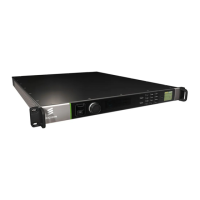B.4 Chassis
B.4.1 Power Consumption
The chassis, without option cards fitted, does not exceed the following total power
requirements.
Table B.22 Chassis Power Consumption Specification
Item Specification
Power Consumption The chassis consumption does not exceed 70 Watts.
The peak current of the AVP 4000 is expected at power on. Maximum inrush
currents are tabulated in Table B.23.
Table B.23 Chassis Peak Inrush Currents
Voltage Maximum Inrush Current
264 V AC (Max. rated AC input) 19.6 A
230 V AC 17 A
110 V AC 10 A
B.5 Environmental
B.5.1 Environmental Conditions
The AVP is for use in non-hostile environments, (i.e. designed for indoor use only
with no protection against dust or water ingress).
Table B.24 Environmental Conditions
Item Specification
Operational
Temperature
–10ºC to +50ºC (14ºF to 122ºF) ambient with free air-flow or –10ºC to +45ºC (14ºF
to 113ºF) for maximum VCM density per chassis. It may require a 10 minute warm-
up period before all clocks are within specification if the ambient temperature is
less than 0ºC
Humidity 0% to 90% (non-condensing)
Cooling Requirements Cool air input from left side of unit, exhaust from right side of unit.
Handling Movement Designed for stationary or fixed use when in operation.
Transportation (Packaged)
Temperature -40°C to +70°C (-40°F to +158°F)
Humidity 0% to 90% (non-condensing)

